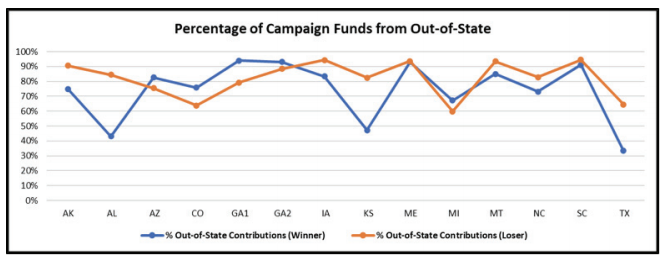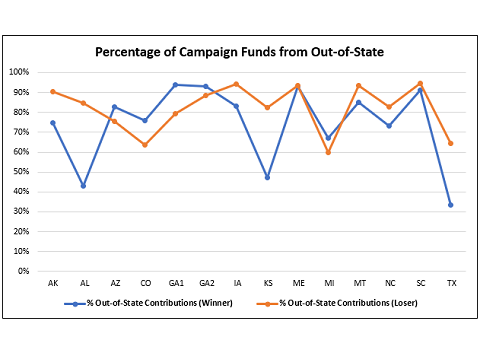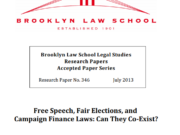PDF of Issue Analysis available here
Issue
Proponents of further restrictions on political spending often argue that money effectively buys elections. To ensure a fairer election process, they maintain it is necessary to limit the inflows of campaign cash so better resourced candidates can’t claim an unfair advantage. Increasingly, political cash does not stop at the state border, and in 2020, donors contributed significantly to federal races outside their home state, sometimes to the opposing candidates’ chagrin. Georgia Republican David Perdue, who lost to Democrat Jon Ossoff in a 2020 runoff election for a U.S. Senate seat, was not fond of the out-of-state contributions received by his opponent, saying “we don’t want people from outside of state trying to come down here and dictate what we’re going to do.”[1] This sentiment, of course, is driven by the belief that money spent on an election unilaterally determines votes received, but further, that this axiom must be the case irrespective of donor geography.
But do out-of-state contributions actually lead to electoral success? This analysis examines that assumption. The results suggest that concern about out-of-state dollars deciding election outcomes is unfounded. This study looks at competitive U.S. Senate races in the 2020 election cycle and finds that most of the candidates who received a greater percentage of their campaign contributions from out-of-state donors than their opponent lost the election.
Analysis
We began by isolating the most highly contested U.S. Senate general election contests from 2020. This avoided the inclusion of highly uncompetitive races where campaign finance matters had little impact on the outcome. Using The Cook Political Report’s Race Ratings issued closest to the election, we disregarded any race ranked “Solid Democrat,” “Likely Democrat,” “Likely Republican,” or “Solid Republican.”[2] None of the races rated “likely” or “solid” produced any upsets.
After identifying the resulting fourteen races, we compiled a list quantifying the donor geography for each of the twenty-eight candidates.[3] A comparison between the winners and losers reveals that the candidate whose campaign received a higher percentage of out-of-state donations lost nine of the fourteen races.[4] Furthermore, the fourteen losers received an average of 81.97% of their campaign contributions from out-of-state, while the fourteen winners received an average of 74.06% of their contributions from out-of-state.

One possible explanation is that out-of-state donations, while financially useful for a candidate, cannot translate directly to votes. An in-state donor might identify their favorite candidate and wish to contribute to aid the campaign. When it later comes time to select a name on the ballot, that donor can vote for their favorite candidate. At least as far as recent Senate elections demonstrate, this means in-state donations, not out-of-state donations, are likely the better metric for electoral success. In-state donors are also in-state voters, so a stronger correlation should not be surprising.
Even so, out-of-state donors can help make more races competitive by allowing challengers to compete with incumbents who have well-established in-state and other fundraising networks. They can also help keep the lights on so fewer candidates have to drop out of the race prematurely.[5]
Conclusion
This study suggests that out-of-state dollars are not as indicative of potential election outcomes as in-state dollars may be. After all, only an in-state donor can signal their intent to vote for a particular candidate by assisting that candidate’s campaign through a monetary contribution. Evidence from the 2020 cycle suggests that it is not money that draws votes after all. More plausibly, it is likable candidates and the prospect of success that attracts campaign contributions and votes. If a candidate raises relatively more money from out-of-state donors compared to their opponent, competitive 2020 Senate races show that the vote count will generally favor the opponent.
Efforts to limit out-of-state donations would likely have little influence on electoral outcomes directly, but such proposals would restrict a valuable source of campaign assistance for political firstcomers who lack the advantages of incumbency. While out-of-state dollars are an asset to a campaign, ultimately, they are not representative of the Americans who can vote for their preferred candidate on Election Day.
Read the full Issue Analysis here.
[1] James Walker, “Perdue Bemoans ‘Out of State’ Cash in Georgia, Takes out of State Donations,” Newsweek. Retrieved on July 21, 2021. Available at: https://www.newsweek.com/perdue-out-state-donations-georgia-elections-1554532 (Dec. 14, 2020).
[2] “2020 Senate Race Ratings,” The Cook Political Report. Retrieved on July 21, 2021. Available at: https://cookpolitical.com/ratings/senate-race-ratings/230641 (Oct. 29, 2020).
[3] See “Institute for Free Speech Issue Analysis No. 11: 2020 Electoral Success by Donor Geography.” Data from the Center for Responsive Politics. Retrieved on July 21, 2021. Available at: https://drive.google.com/file/d/1hx6q7yyNSZ3ipRfjkxRCoDxTGDhbyAyO/view (2021).
[4] The data for in-state vs. out-of-state donations rely on the Center for Responsive Politics’ methodology. It is unclear if the Center’s data set includes all donations or only itemized donations.
[5] David Keating, “Campaign finance limits take choices away from voters,” Washington Examiner. Retrieved on July 21, 2021. Available at: https://www.washingtonexaminer.com/opinion/campaign-finance-limits-take-choices-from-voters (Dec. 17, 2019).














